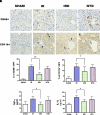[D-Ala2, D-Leu5] Enkephalin Attenuates Hepatic Ischemia-Reperfusion Injury in Cirrhotic Rats
- PMID: 35599785
- PMCID: PMC9121017
- DOI: 10.3389/fsurg.2022.839296
[D-Ala2, D-Leu5] Enkephalin Attenuates Hepatic Ischemia-Reperfusion Injury in Cirrhotic Rats
Abstract
Background and aims: Hepatic ischemia-reperfusion injury (IRI) is a common phenomenon that occurs after liver transplantation and liver tumor surgery. It can cause liver dysfunction and recovery failure after liver surgery, even leading to acute liver failure. Our aim is to investigate the protective effect and related potential mechanism of [D-Ala2, D-Leu5] enkephalin (DADLE) treatment on hepatic IRI in cirrhotic livers of rats.
Methods: The models of liver cirrhosis and hepatic IRI were established with male Sprague-Dawley rats. DADLE at a dose series of 0.5, 1, or 5 mg·kg-1 was injected intravenously to rats 10 min prior hepatic ischemia, followed by a 6- h reperfusion. The serum levels of alanine aminotransferase (ALT) and aspartate aminotransferase (AST), histological changes, and liver cell apoptosis were used to assess liver IRI. The optimal dose of DADLE was assessed by using the Suzuki score and ALT and AST levels. We repeated the hepatic IRI procedure on the optimal dose of the DADLE group and the delta opioid receptor (DOR) antagonist natrindole hydrochloride (NTD) injection group. Serum ALT and AST levels, histological staining, hepatic apoptosis, and serum levels of tumor necrosis factor alpha (TNF-α) and interleukin 1 β (IL-1β) were measured. The expression of protein kinase B (Akt) and its downstream proteins were evaluated by using quantitative real-time polymerase chain action (qRT-PCR) and Western blotting.
Results: Compared with the control group, DADLE treatment at a dose of 5 mg·kg-1 reduced the Suzuki score (mean: 5.8, range: 5.0-6.6 vs. mean: 8.0, range: 7.0-8.9), the ALT level (134.3 ± 44.7 vs. 247.8 ± 104.6), and the AST (297.1 ± 112.7 vs. 660.8 ± 104.3) level. DOR antagonist NTD aggravated hepatic IRI. Compared with the control group, DADLE treatment decreased the number of apoptosis cells and microphages and neutrophils, increased the expression of Akt and its mRNA to much higher levels, and upregulated the mRNA and protein expression of Bcl-2 and Bcl-2-associated death promoter (BAD).
Conclusion: DADLE treatment at a dose of 5 mg·kg-1 injected intravenously 10 min prior hepatic ischemia could contain rats' hepatic IRI by activating DOR in cirrhotic livers. The effects of DADLE could be offset by NTD. The potential molecular mechanism seems to be involved in the phosphatidylinositol-3-kinase (PI3K)/Akt pathway.
Keywords: DADLE; cirrhotic livers; delta opioid receptor; hepatic ischemia–reperfusion injury; phosphatidylinositol-3-kinase (PI3K)/Akt pathway; rats.
Copyright © 2022 Liu, Wang, Pan, Chen, Qu, Zhu, Zheng and Fan.
Conflict of interest statement
The authors declare that the research was conducted in the absence of any commercial or financial relationships that could be construed as a potential conflict of interest.
Figures





Similar articles
-
Protective Effects of Geniposide on Hepatic Ischemia/Reperfusion Injury.Transplant Proc. 2017 Jul-Aug;49(6):1455-1460. doi: 10.1016/j.transproceed.2017.02.063. Transplant Proc. 2017. PMID: 28736023
-
[D-Ala2, D-Leu5] Enkephalin Improves Liver Preservation During Normothermic Ex Vivo Perfusion.J Surg Res. 2019 Sep;241:323-335. doi: 10.1016/j.jss.2019.04.010. Epub 2019 May 6. J Surg Res. 2019. PMID: 31071481
-
[Establishment and applicability comparison of four models of acute liver ischemia/reperfusion injury in rat].Zhonghua Wei Zhong Bing Ji Jiu Yi Xue. 2023 Jun;35(6):604-609. doi: 10.3760/cma.j.cn121430-20230228-00123. Zhonghua Wei Zhong Bing Ji Jiu Yi Xue. 2023. PMID: 37366126 Chinese.
-
Delta opioid peptide (D-Ala 2, D-Leu 5) enkephalin: linking hibernation and neuroprotection.Front Biosci. 2004 Sep 1;9:3392-8. doi: 10.2741/1490. Front Biosci. 2004. PMID: 15353366 Review.
-
MicroRNAs: Novel Targets in Hepatic Ischemia-Reperfusion Injury.Biomedicines. 2022 Mar 29;10(4):791. doi: 10.3390/biomedicines10040791. Biomedicines. 2022. PMID: 35453542 Free PMC article. Review.
References
-
- Panel M, Ruiz I, Brillet R, Lafdil F, Teixeira-Clerc F, Nguyen CT, et al. Small-molecule inhibitors of cyclophilins block opening of the mitochondrial permeability transition pore and protect mice from hepatic ischemia/reperfusion injury. Gastroenterology. (2019) 157(5):1368–82. 10.1053/j.gastro.2019.07.026 - DOI - PubMed
LinkOut - more resources
Full Text Sources
Research Materials

